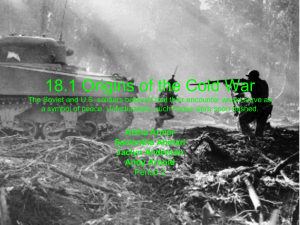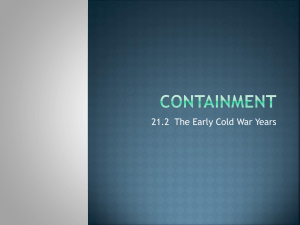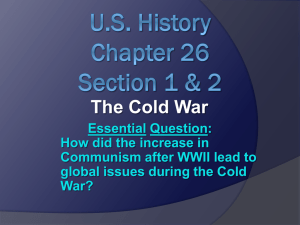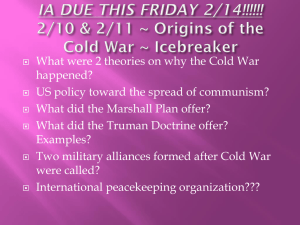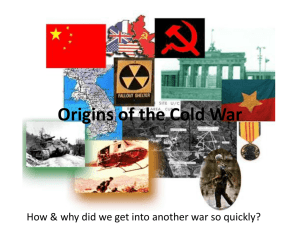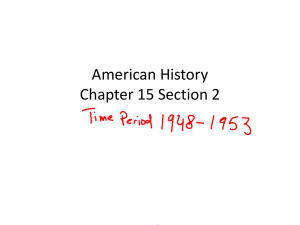Cold War
advertisement
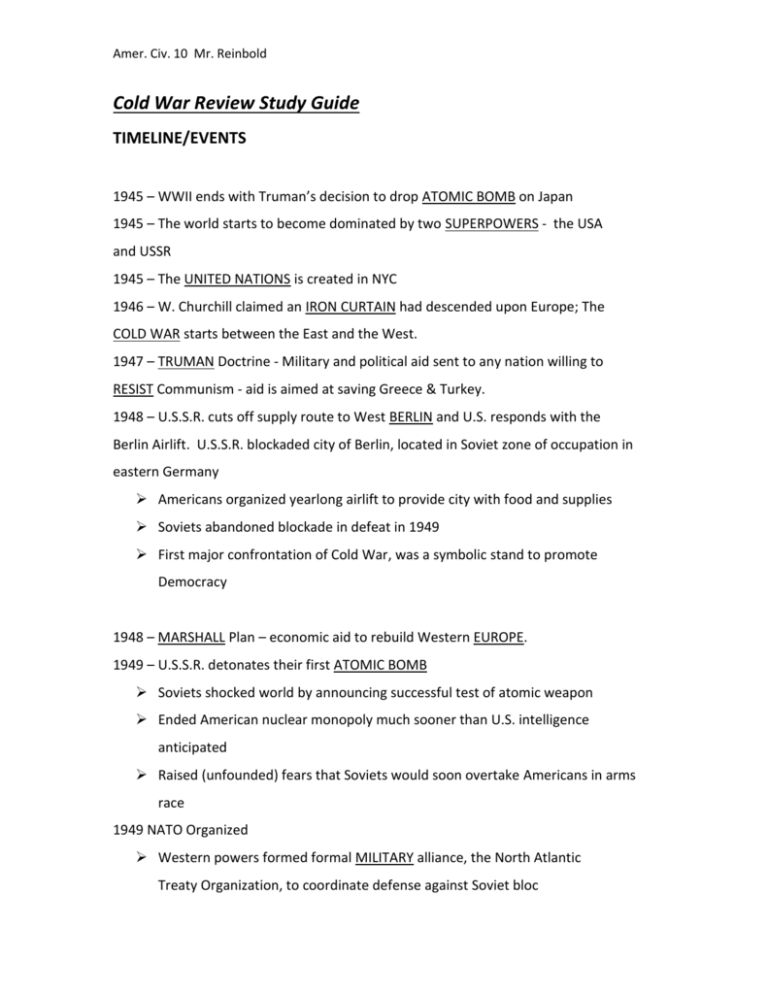
Amer. Civ. 10 Mr. Reinbold Cold War Review Study Guide TIMELINE/EVENTS 1945 – WWII ends with Truman’s decision to drop ATOMIC BOMB on Japan 1945 – The world starts to become dominated by two SUPERPOWERS - the USA and USSR 1945 – The UNITED NATIONS is created in NYC 1946 – W. Churchill claimed an IRON CURTAIN had descended upon Europe; The COLD WAR starts between the East and the West. 1947 – TRUMAN Doctrine - Military and political aid sent to any nation willing to RESIST Communism - aid is aimed at saving Greece & Turkey. 1948 – U.S.S.R. cuts off supply route to West BERLIN and U.S. responds with the Berlin Airlift. U.S.S.R. blockaded city of Berlin, located in Soviet zone of occupation in eastern Germany Americans organized yearlong airlift to provide city with food and supplies Soviets abandoned blockade in defeat in 1949 First major confrontation of Cold War, was a symbolic stand to promote Democracy 1948 – MARSHALL Plan – economic aid to rebuild Western EUROPE. 1949 – U.S.S.R. detonates their first ATOMIC BOMB Soviets shocked world by announcing successful test of atomic weapon Ended American nuclear monopoly much sooner than U.S. intelligence anticipated Raised (unfounded) fears that Soviets would soon overtake Americans in arms race 1949 NATO Organized Western powers formed formal MILITARY alliance, the North Atlantic Treaty Organization, to coordinate defense against Soviet bloc Amer. Civ. 10 Mr. Reinbold 1949 Fall of China MAO ZEDONG’s Communists defeated Chiang Kai-Shek's Nationalists to end long Chinese Civil War Nationalists fled to TAIWAN Many Americans blamed (unfairly) TRUMAN Administration for "loss of China" 1950 – Korean War begins; as a result United Nations “police action” begins to defend S. Korea Communist North Koreans invaded anticommunist South Korea, nearly captured entire country Americans drove North Koreans all the way to border with China, prompting surprise intervention by Chinese troops, which then drove Americans back toward south War ended in stalemate, with both sides dug in near original 1950 border 1950 – (R) Sen. McCARTHY claims communists have infested the government, starts 2nd RED Scare 1951 – ROSENBERGS are tried and sentenced for providing nuclear secrets to the Soviets; they were executed two years later. 1952 – The first HYDROGEN BOMB (H-BOMB) is detonated by U.S 1955 – MUTUALLY ASSURED DESTRUCTION or MAD Plan introduced by John Foster Dulles 1955 – Soviets created WARSAW Pact to offset/counter Western Europe’s NATO 1953 – Stalin Dies 1956 – New Soviet leader Nikita Khrushchev takes over after a power struggle following Stalin’s death several years earlier. 1957 – SPUTNIK launches the U.S. & Soviets into a SPACE race. Is the world’s 1st satellite to be launched into space and leads to anxiety in America over the idea of falling behind the SOVIETS; shocked many Americans, spurring huge increase in government spending on math, science, and defense. 1957 – Eisenhower Doctrine becomes policy after tensions rise in the Middle East Amer. Civ. 10 Mr. Reinbold 1958 – NASA created – mainly as a result of the Sputnik satellite launch 1959 – Communist dictator Fidel Castro (Cuba) takes power 1960 – Francis Gary Powers is shot down in his U–2 spy plane over U.S.S.R. Relations between U.S. and U.S.S.R., which had been thawing, grew colder again COLD WAR LEADERS/IMPORTANT PEOPLE Winston Churchill * Prime Minister of GREAT BRITAIN from 1940-45, again from 1951-55 *Close friend of America’s in World War II and the Cold War * After 1945, favored strong stand against Soviets; delivered famous "IRON CURTAIN" speech in Missouri, 1946 Harry S Truman * Democratic Vice President under President Franklin D. Roosevelt * Became President after Roosevelt's death in April 1945, during last months of World War II * Met with Stalin at Potsdam, soon led U.S. into anti-Soviet Cold War posture *Truman establishes CONTAINMENT as America’s foreign policy in the 1947 Truman Doctrine Joseph (Josef) Stalin * Soviet dictator from mid-1920’s until death in 1953 * Allied with U.S. and Britain during World War II; part of the “Big Three” * In negotiations over postwar order, demanded Soviet domination of Eastern Europe in order to guarantee Soviets would not be invaded again by Germany * Became fearsome enemy of U.S. in early years of Cold War Nikita KHRUSHCHEV Amer. Civ. 10 Mr. Reinbold * Soviet leader following Stalin's death, 1953 * Initially more open to dialogue with West and within Soviet sphere * Denounced Stalin's crimes in secret speech to Soviet leadership, 1956 * Adopted a harder line against West after 1960; led Soviet Union during Cuban Missile Crisis George Kennan * American diplomat, author of "LONG TELEGRAM" that proposed U.S. policy of containment of U.S.S.R., 1946 * Kennan's thinking shaped American policy through early years of Cold War Dwight D. Eisenhower * Republican President of the U.S. in 1952 and again in 1956 * Served as Supreme Commander of Allied forces in Europe during WORLD WAR II * Took office promising to end stalemate of unpopular Korean War *Foreign Policy idea: BRINKSMANSHIP – pushing countries to the edge of nuclear war if needed in order to prevail in a foreign policy situation ORGANIZATIONS NATO * North ATLANTIC Treaty ORGANIZATION * Military alliance of U.S. and Western European formed to unite defense against U.S.S.R. Warsaw Pact * Communist counterpart to NATO * Comprised of Soviet Union and Soviet satellite nations of Eastern Europe Amer. Civ. 10 Mr. Reinbold The CIA = CENTRAL INTELLIGENCE AGENCY * Organized in 1947 to oversee all foreign intelligence and counterintelligence operations for United States * During Eisenhower administration, covert (secret) action is widely used; Soviets counter with their spy agency called the KGB. CONCEPTS CONTAINMENT * American policy built upon assumption that U.S.S.R. was by nature an expansionist but cautious power, and thus U.S. should meet every attempt to expand Soviet influence with appropriate "counterforce" * Proposed by diplomat George F. KENNAN, adopted as policy in the Truman Doctrine *This policy went against those who wanted to CONFRONT the Soviet Union more directly with force Truman Doctrine *Provide military and political aid, not troops, to countries willing to resist COMMUNISM *Helped GREECE and TURKEY survive Communist aggression in 1947 Eisenhower Doctrine * U.S. formally extended policy of containment to cover Middle East; was a more “aggressive brand” of Containment than earlier Truman years * U.S. willing to send troops in limited situations to back-up foreign policy Brinksmanship Amer. Civ. 10 Mr. Reinbold * Practice of pushing conflict to brink of disaster in order to force opponent to relent * Practiced by Cold War leaders in Washington and Moscow in Berlin Airlift; though it occurs during the Truman years – it becomes a key idea/concept during the EISENHOWER years DOMINO Theory * American foreign policy theory that suggested that the fall of one nation to Communism would encourage spread of Communism to neighboring countries * Encouraged hard line against Communist expansion, anywhere and everywhere PRACTICE QUESTIONS 1. Nations that are much more powerful than the other nations of the world are called SUPERPOWERS. The two of these during the Cold War were the USA and the USSR. 2. The United States led an organization called NATO 3. The Soviet Union led an organization called WARSAW PACT 4. The Americans did not want communism to spread. This policy was called CONTAINMENT 5. Schoolchildren were told to practice DUCK AND COVER drills in case of a nuclear bomb blast. 6. People were encouraged to make BOMB (FALLOUT) SHELTERS where they could live if there was a nuclear attack. 7. The Cold War was a battle of IDEAS between the Superpowers; 8. IDEOLOGY - A set or ideas or beliefs 9. The prize of the Cold War was world DOMINATION by whichever side that won. 10. The Cold War went on from 1945 until 1991 11. Who said, “An Iron Curtain has descended across…Europe”? CHURCHILL Amer. Civ. 10 Mr. Reinbold 12. The TRUMAN DOCTRINE was a policy that provided military and political aid to any nation willing to resist Communism. 13. The MARSHALL PLAN helped Western Europe rebuild after WWII and to resist the spread of Communism. 14. President Truman chose to AIRLIFT supplies into West Berlin during the crisis over Berlin in 1948-1949 in order to avoid war and maintain DEMOCRACY in that city 15. What is the difference between a Cold War and Hot War? A HOT WAR INVOLVES DIRECT MILITARY CONFLICT -- COLD WAR IS A COMPETITION OF IDEAS (Basic Def.) 16. Countries from Eastern Europe joined with the USSR to form the WARSAW Pact. 17. Countries that followed the lead/directions of the USSR during the Cold War were known as “SATELLITE” nations. 18. The following are major countries that belong to NATO: The U.S., West Germany, Italy, France, and GREAT BRITAIN. 19. Which countries belong to the Nuclear Club? U.S., Soviet Union (USSR), China, Great Britain, France, INDIA, and PAKISTAN. North Korea has detonated nuclear material and the U.S. is currently worried that IRAN might try to develop a nuclear bomb. 20. The UN stands for the UNITED NATIONS. It goal is to promote PEACE and COOPERATION among the nations of the World. It is headquartered in NEW YORK CITY. 21. What was the result of the Korean War? A victory for the U.S.? _____________ _________________________________________________________________. 22. The House Committee for Un-American Activities did what? _________________ _________________________________________________________________. 23. What does MAD stand for during the Cold War Era? MUTUALLY ASSURED DESTRUCTION Amer. Civ. 10 Mr. Reinbold



